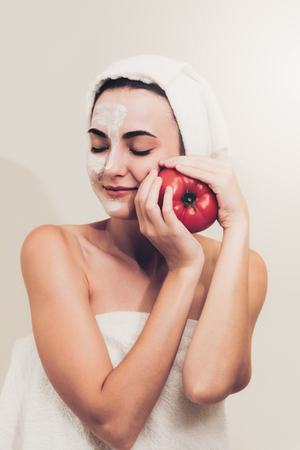1. The Link Between Sun Exposure and Premature Aging
Many people associate aging with the natural passing of time, but did you know that the sun is one of the biggest contributors to premature aging? Ultraviolet (UV) rays from the sun penetrate deep into the skin, breaking down essential proteins and triggering damage that leads to wrinkles, fine lines, and hyperpigmentation.
How UV Rays Accelerate Skin Aging
UV radiation is divided into two main types: UVA and UVB. Both play a role in skin aging, but in different ways:
| Type of UV Rays | Effects on Skin |
|---|---|
| UVA Rays | Penetrate deep into the skin, breaking down collagen and elastin, leading to sagging and wrinkles. |
| UVB Rays | Affect the outer layer of the skin, causing sunburns and contributing to uneven pigmentation over time. |
The Impact on Collagen and Elastin
Your skin relies on collagen and elastin to maintain its firmness and elasticity. However, prolonged sun exposure speeds up their degradation, making your skin less resilient. This results in visible signs of aging such as:
- Wrinkles and Fine Lines: Reduced collagen leads to creases forming around the eyes, forehead, and mouth.
- Sagging Skin: Elastin breakdown causes loss of firmness, leading to drooping skin.
- Hyperpigmentation: Sunspots and uneven skin tone develop due to increased melanin production.
The Role of SPF in Preventing Premature Aging
Sunscreen with SPF (Sun Protection Factor) acts as a shield against harmful UV rays. By applying a broad-spectrum SPF daily, you can significantly reduce your risk of sun-induced aging. Look for formulas with at least SPF 30 for effective protection.
2. Understanding SPF: What It Really Means
When choosing a sunscreen, you’ve probably noticed different SPF numbers on the label. But what do these numbers actually mean, and how do they protect your skin? Let’s break it down in a simple way.
Breaking Down SPF Numbers
SPF stands for Sun Protection Factor, which measures how well a sunscreen protects your skin from UVB rays—the type of ultraviolet radiation that causes sunburn and contributes to skin cancer. The higher the SPF, the greater the protection.
| SPF Level | % of UVB Rays Blocked |
|---|---|
| SPF 15 | 93% |
| SPF 30 | 97% |
| SPF 50 | 98% |
| SPF 100 | 99% |
You might think SPF 100 offers double the protection of SPF 50, but as you can see, the difference is minimal. No sunscreen can block 100% of UVB rays, which is why reapplication is just as important as choosing the right SPF level.
Chemical vs. Physical Sunscreens: What’s the Difference?
Sunscreens come in two main types: chemical and physical (also known as mineral). Both provide protection, but they work differently.
| Chemical Sunscreen | Physical Sunscreen | |
|---|---|---|
| Main Ingredients | Oxybenzone, Avobenzone, Octinoxate, etc. | Zinc Oxide, Titanium Dioxide |
| How It Works | Absorbs UV rays and converts them into heat before releasing them from the skin. | Sits on top of the skin and physically blocks or reflects UV rays. |
| Texture & Feel | Lighter, blends easily into the skin. | Thicker consistency, may leave a white cast. |
| Sensitivity & Suitability | Might cause irritation for sensitive skin types. | Bestsuited for sensitive skin; less likely to cause irritation. |
| Reef-Safe Options? | Certain ingredients may harm coral reefs. | Zinc oxide & titanium dioxide are generally reef-safe. |
If you have sensitive skin or prefer eco-friendly options, a physical sunscreen may be better for you. If you want something lightweight that absorbs quickly, a chemical sunscreen could be a great choice.
The Bottom Line on SPF Protection
No matter which type of sunscreen you choose, applying it daily is key to protecting your skin from premature aging and sun damage. Look for broad-spectrum sunscreens with at least SPF 30 and remember to reapply every two hours—especially if youre sweating or swimming!
![]()
3. Daily Sunscreen Use: The Key to Youthful Skin
Many people think sunscreen is only necessary on sunny days or when spending time outdoors. However, UV rays are present even on cloudy days and can penetrate windows, meaning your skin is still exposed to harmful effects indoors. Incorporating sunscreen into your daily skincare routine is one of the most effective ways to prevent premature aging and protect your skin’s overall health.
Why Daily Sunscreen Matters
Consistent sunscreen use helps shield the skin from both UVA and UVB rays. UVA rays contribute to premature aging by breaking down collagen and causing wrinkles, while UVB rays lead to sunburns and increase the risk of skin cancer. Since these rays can reach you even when youre inside or when the sky is overcast, applying sunscreen every day is essential.
How UV Rays Affect Your Skin
| Type of UV Ray | Main Effects on Skin |
|---|---|
| UVA | Causes wrinkles, fine lines, and loss of elasticity by penetrating deep into the skin. |
| UVB | Leads to sunburns and increases the risk of skin cancer by damaging the surface layers of the skin. |
Sunscreen Indoors and on Cloudy Days
You might assume that staying inside protects you from UV damage, but many indoor light sources and electronic screens emit low levels of blue light that can contribute to skin aging. Additionally, UVA rays can penetrate windows, making it crucial to wear sunscreen even when indoors.
Best Practices for Daily Sunscreen Use
- Choose a broad-spectrum SPF 30+ sunscreen: This ensures protection against both UVA and UVB rays.
- Apply sunscreen as the last step in your morning routine: Use it after moisturizer but before makeup.
- Reapply every two hours: If you’re indoors with window exposure or outdoors, reapplying helps maintain protection.
- Don’t forget often-missed areas: Apply sunscreen to your neck, ears, hands, and lips.
A Simple Step for Long-Term Benefits
The habit of applying sunscreen daily is a small but powerful way to keep your skin youthful, radiant, and protected. By making it a non-negotiable part of your routine, you significantly reduce the chances of premature aging and long-term damage caused by UV exposure.
4. Choosing the Right Sunscreen for Your Skin Type
Finding the perfect sunscreen can feel overwhelming with so many options available. The key is to choose one that suits your skin type, lifestyle, and personal preferences. Using the right sunscreen ensures maximum protection while keeping your skin comfortable and healthy.
Understanding Your Skin Type
Different skin types have different needs when it comes to sunscreen. Here’s a quick guide to help you pick the best option:
| Skin Type | Best Sunscreen Features |
|---|---|
| Oily Skin | Oil-free, lightweight, matte finish, non-comedogenic |
| Dry Skin | Hydrating, contains ingredients like hyaluronic acid or glycerin |
| Sensitive Skin | Fragrance-free, mineral-based (zinc oxide or titanium dioxide), hypoallergenic |
| Combination Skin | BALANCED formula—hydrating yet non-greasy, lightweight texture |
| Mature Skin | Sunscreen with added antioxidants and anti-aging ingredients like peptides or niacinamide |
| Acne-Prone Skin | Oil-free, non-comedogenic, lightweight gel or fluid formula |
Chemical vs. Mineral Sunscreens: Which One Is Best?
The two main types of sunscreens—chemical and mineral—offer different benefits. Understanding how they work can help you make an informed choice.
| Sunscreen Type | Main Benefits | Best For |
|---|---|---|
| Chemical Sunscreen | – Absorbs UV rays and converts them into heat – Lightweight and easy to apply – Often found in daily moisturizers and makeup products |
– Normal to oily skin – Everyday wear under makeup – Those who prefer a lightweight feel |
| Mineral Sunscreen (Physical) | – Sits on top of the skin to reflect UV rays – Ideal for sensitive skin – Provides immediate protection after application |
– Sensitive or acne-prone skin – Those who prefer natural ingredients – People with rosacea or irritation-prone skin |
Lifestyle Considerations When Choosing Sunscreen
Your daily routine and activities should also influence your sunscreen choice:
- If you spend long hours outdoors: Choose a water-resistant sunscreen with SPF 50+.
- If you wear makeup daily: Opt for a lightweight SPF moisturizer or a tinted sunscreen.
- If you have an active lifestyle: Pick a sweat-resistant formula that won’t clog pores.
- If you prefer eco-friendly options: Look for reef-safe mineral sunscreens without oxybenzone or octinoxate.
- If you have darker skin tones: Choose a sheer or tinted sunscreen to avoid white cast.
Tips for Finding the Perfect Sunscreen for You
If youre still unsure which sunscreen to choose, consider these additional tips:
- Patches test first: Apply a small amount on your wrist or behind your ear to check for any reactions.
- Avoid harsh chemicals: If you have sensitive skin, stay away from alcohol-based formulas and added fragrances.
- Select broad-spectrum protection: Always choose sunscreens labeled “broad-spectrum” to shield against both UVA and UVB rays.
- Ditch heavy creams if you have oily skin: Gel-based sunscreens work better for those prone to breakouts.
- Avoid flashback in photos: Some sunscreens with high zinc oxide can cause a white cast under flash photography; tinted versions help minimize this effect.
- Simplify your routine: A moisturizer with SPF can be great for everyday use if layering multiple products feels too heavy.
The right sunscreen makes all the difference in protecting your skin from premature aging and sun damage. By considering your skin type, lifestyle, and personal preferences, you can find a formula that works perfectly for you!
5. Beyond Sunscreen: Comprehensive Sun Protection
While sunscreen is a crucial part of any anti-aging skincare routine, it’s not the only way to protect your skin from harmful UV rays. Incorporating additional protective measures can further safeguard your skin and help maintain a youthful, healthy appearance.
Wear Protective Clothing
One of the simplest ways to shield your skin from the sun is by wearing protective clothing. Opt for long-sleeved shirts, pants, and fabrics with a tight weave that block UV rays. Some clothing is even designed with built-in UPF (Ultraviolet Protection Factor) for added defense.
Use Hats and Sunglasses
A wide-brimmed hat can provide shade for your face, neck, and ears—areas often exposed to direct sunlight. Sunglasses with UV protection help prevent eye damage and reduce squinting, which can lead to fine lines around the eyes.
Seek Shade Whenever Possible
Avoiding direct sun exposure during peak hours (10 AM to 4 PM) can significantly reduce UV damage. If you’re outdoors, try to stay under umbrellas, trees, or other shaded areas to minimize your skin’s exposure.
Comparison of Sun Protection Methods
| Protection Method | Benefits |
|---|---|
| Sunscreen (SPF 30+) | Blocks harmful UV rays and prevents premature aging |
| Protective Clothing | Covers skin to minimize direct sun exposure |
| Hats & Sunglasses | Shields sensitive areas like the face and eyes |
| Seeking Shade | Reduces overall UV radiation exposure |
Create a Well-Rounded Sun Protection Routine
The best approach to sun protection involves combining multiple strategies. Wearing sunscreen daily is essential, but pairing it with protective clothing, accessories, and smart habits will provide more comprehensive defense against aging and sun damage.


